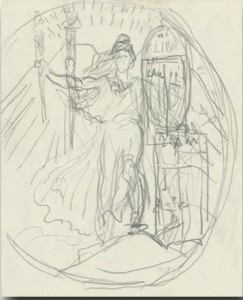
In the early 1900’s President Theodore Roosevelt called for a “renaissance” in American coinage.
He thought the coins of that era were unattractive and wanted them to instead embody our national identity and growing preeminence on the world stage. The United States of America, a bold experiment in liberty and representative democracy, had not only succeeded, it had come of age. And its coins should reflect that, Roosevelt felt. Coins were one of the most visible, tangible representations of a country.
It was this sense of purpose that led Roosevelt to choose Augustus Saint- Gaudens to redesign America’s coins. Saint-Gaudens was a renowned sculptor and an artist who shared the President’s vision for expressing America’s national identity visually through art.
In 1905, President Roosevelt personally invited Saint-Gaudens to redesign American coinage, specifically U.S. gold pieces. What emerged has been called the most beautiful coin ever minted in the U.S. and perhaps the world — the 1907 $20 gold piece, also known as the Double Eagle.
On the obverse, Saint-Gaudens shows Liberty, personified by a statuesque woman striding powerfully forward. Liberty’s robe harkens back to our roots as a republic based on the ideals of ancient Greece and Rome. Liberty is leading the way with a torch in her front hand and an olive branch in the back hand. This design underscores that liberty is central to the American spirit, is beautiful and attractive to all, and wherever Liberty goes, inspired by enlightenment, peace follows. The United States Capitol dome is also depicted in the background, meaning that through representative democracy, liberty has been fully achieved in America, strengthening her position to go forth throughout the world.
A young eagle flying during a sunrise is depicted on the reverse. This is America, young and strong, in its ascendancy with a bright future before it. The motto, “E PLURIBUS UNUM” is on the edge of the coin, allowing a cleaner design on the obverse and reverse. These stylistic elements represented the visual embodiment of America and made it the definitive American coin.
There were four variations of the 1907 Double Eagle. The first two attempts were considered ultra high relief (also referred to as extremely high relief), a 34-mm version and a 27-mm version, both with Roman numerals. The coining process for the 34-mm version was too arduous, and the United States Mint would later find out it had no authority to mint the 27-mm version. Its third attempt reduced the relief, and was struck in 34-mm version with Roman numerals. Because its relief was reduced, it did not require as much metal flow to fill the design, and was more suitable for mass production and approximately 12,000 were made. Finally, in December 1907, a fourth variation was produced, an even lower relief 34-mm version, with Arabic numerals.
Despite Saint-Gaudens’ artistic masterpiece, the minting process of the day was not conducive to high relief coins, which he and Roosevelt specifically desired. As a result, despite being considered one of the most beautiful gold pieces ever minted, Saint-Gaudens’ full vision for the production of an ultra high relief coin was never realized.
2009 Ultra High Relief Double Eagle
In January 2009, the United States Mint issued the 2009 Ultra High Relief Double Eagle Gold Coin. This coin promises to fulfill Augustus Saint-Gaudens’ vision of an ultra high relief coin that could not be realized in 1907 with his legendary Double Eagle liberty design.
The 2009 Ultra High Relief Double Eagle Gold Coin shows the Nation and the world the very best the United States Mint has to offer. The 21st century vision of the United States Mint, combined with technological advances, enabled the United States Mint to realize the previously unattainable goal of making the coin accessible to all Americans.
Through 21st century technology and the vision of Director Ed Moy, original Saint-Gaudens coin plasters were digitally mapped by the United States Mint. Using the digital design and die-making process, the Saint-Gaudens sculpture—in ultra high relief—has been updated to reflect the year 2009, an additional four stars to represent the current 50 states, and the inscription “In God We Trust,” which was not on the 1907 version.
Additionally, a small border was added for a more consistent edge. The 2009 coin will be made of 24-karat gold. Pure 24-karat gold is much more malleable than 22-karat or 90% gold coins, making it better material for striking the ultra high relief.
The United States Mint looks forward to the 21st century and a new era of modern coinage. It eagerly continues the tradition of embodying America’s spirit and identity through its coins and medals. The coin is a uniquely American artistic expression—created by an American sculptor and crafted by an iconic American institution.
The 2009 Ultra High Relief Double Eagle Gold Coin closes one chapter of American coin design and begins a new one. We have perfected what has been called one of the most beautiful coins in the world, but, like America itself, there is much more on the horizon.
Double Eagle Gold Coins
- 1907 Double Eagle $20 Gold Coin
- 2009 Ultra High Relief Double Eagle Gold Coin


